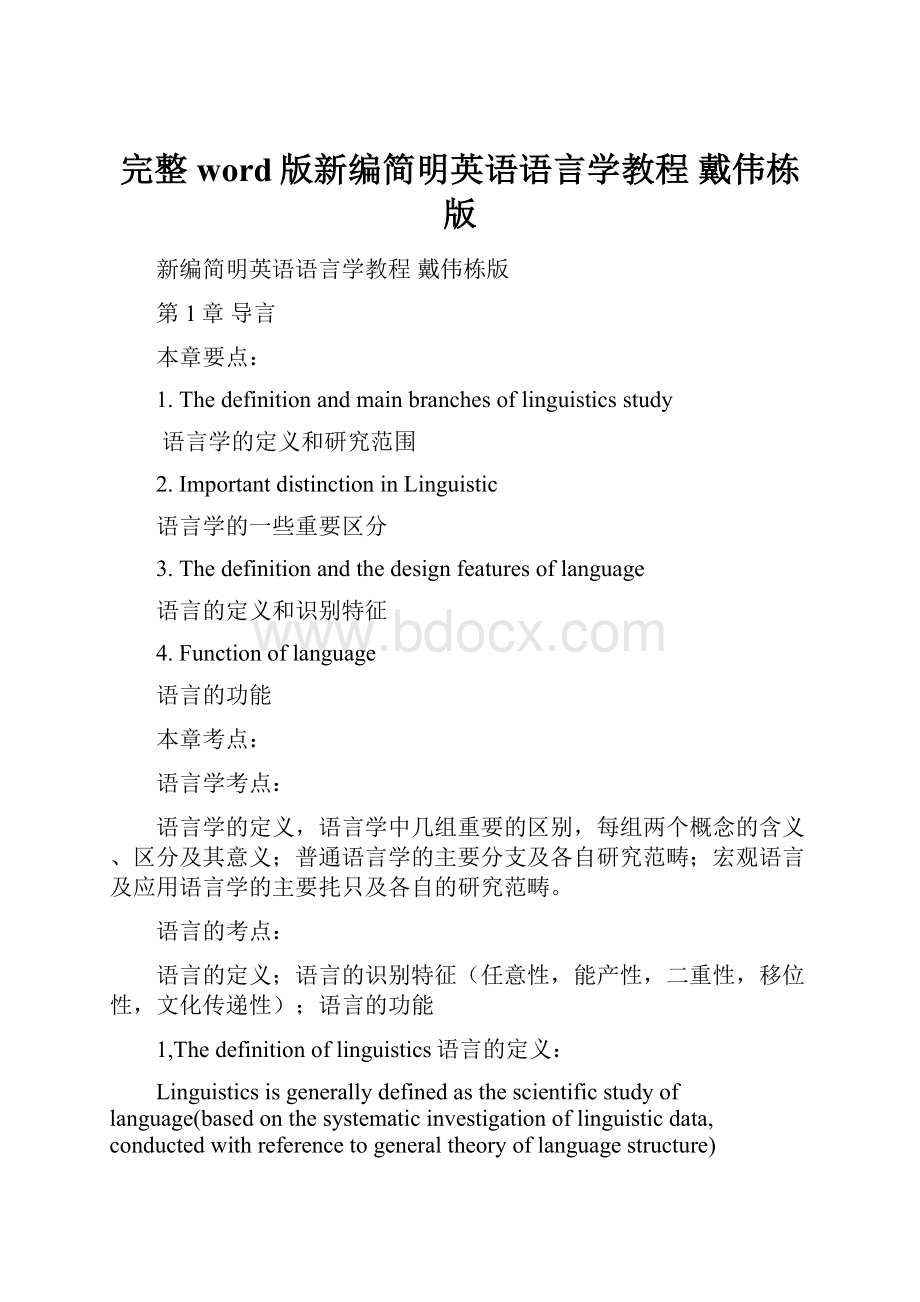完整word版新编简明英语语言学教程 戴伟栋版.docx
《完整word版新编简明英语语言学教程 戴伟栋版.docx》由会员分享,可在线阅读,更多相关《完整word版新编简明英语语言学教程 戴伟栋版.docx(40页珍藏版)》请在冰豆网上搜索。

完整word版新编简明英语语言学教程戴伟栋版
新编简明英语语言学教程戴伟栋版
第1章导言
本章要点:
1.Thedefinitionandmainbranchesoflinguisticsstudy
语言学的定义和研究范围
2.ImportantdistinctioninLinguistic
语言学的一些重要区分
3.Thedefinitionandthedesignfeaturesoflanguage
语言的定义和识别特征
4.Functionoflanguage
语言的功能
本章考点:
语言学考点:
语言学的定义,语言学中几组重要的区别,每组两个概念的含义、区分及其意义;普通语言学的主要分支及各自研究范畴;宏观语言及应用语言学的主要扥只及各自的研究范畴。
语言的考点:
语言的定义;语言的识别特征(任意性,能产性,二重性,移位性,文化传递性);语言的功能
1,Thedefinitionoflinguistics语言的定义:
Linguisticsisgenerallydefinedasthescientificstudyoflanguage(basedonthesystematicinvestigationoflinguisticdata,conductedwithreferencetogeneraltheoryoflanguagestructure)
2.Thescopeoflinguistics语言学的范围
A:
micro-linguistics
Phonetics(语音学):
thestudyofthesoundsusedinlinguisticcommunication.
Phonology(音系学):
thestudyofhowsoundsputtogetherandusedtoconveymeaningincommunication.(语音分布和排列的规则及音节的形式)
Morphology(形态学):
thestudyofthewayinwhichthesymbolsarearrangedandcombinedtoformwords.
Syntax(句法学):
thestudyofrulesinthecombinationofwordstoformgrammaticallypermissiblesentencesinlanguage.
Semantics(语义学):
thestudyofmeaning.
Pragmatics(语用学):
thestudyofthemeaninginthecontextoflanguageuse.
B:
macro-linguistics
Sociolinguistics:
thestudyofallsocialaspectsoflanguageanditsrelationwiththesocietyformthecoreofthebranch.
Psycholinguistics:
thestudyoflanguageanditsrelationwithpsychology.
Appliedlinguistics:
thestudyofapplicationoflanguagetothesolutionofpracticalproblems.Narrowlyitistheapplicationoflinguistictheoriesandprinciplestolanguageteaching,especiallytheteachingofforeignandsecondlanguages.
3.Someimportantdistinctionsinlinguistics语言学中的重要区分
A:
DescriptivevsPrescriptive描写式与规定式
Descriptive:
ifalinguisticstudyaimstodescribeandanalyzethelanguagepeopleactuallyuse.
Prescriptive:
ifthelinguisticstudyaimstolaydownrulesfor“correctandstandard”behaviorinusinglanguage,i.e.totellpeoplewhatshouldtheysayandwhattheyshouldnotsay,itissaidtobePrescriptive.
B:
SynchronicvsDiachronic共时性和历时性
Synchronic:
thedescriptionofalanguageatsomepointoftimeinhistoryisasynchronicstudy.
Diachronic:
thedescriptionofalanguageasitchangesthroughtimeisadiachronicstudy.
C:
Speechvswriting言语和文学
Thesearemajormediaofcommunication.
D:
Languevsparole语言与言语(Saussure索緖尔)
Langue:
referstotheabstractlinguisticsystemsharedbytheallthemembersofaspeechcommunity.
Parole:
referstotherealizationoflanguageinactualuse.
E:
Competencevsperformance语言能力和语言应用(Chomsky乔姆斯基)
Competence:
referstoauser’sunderlyingknowledgeaboutthesystemoftherules.
Performance:
referstotheactualuseinconcretesituations.
乔姆斯基和索绪尔的区别:
索绪尔采用的是社会学的观点,他的语言观念是社会惯例性的。
乔姆斯基从心理学角度看待语言,对他而言,语言能力是每个个体的大脑特征。
E:
TraditionalGrammarvsmodernlinguistics传统语法与现代语言学
Saussure的《CourseinGeneralLinguistics》标志着现代语言学的开端。
区别:
a:
语言学是descriptive,传统的语法是prescriptive.
b:
现代语言学认为口头语是基本的,而不是书面语。
c:
现代语言学并不强迫进入一个拉丁语为基础的框架。
4.Thedefinitionoflanguage语言的定义
Languageisasystemofarbitraryvocalsymbolsusedforhumancommunication.
5.Thedesignfeaturesoflanguage语言的识别特征
Thedesignfeaturesofhumanlanguagecanbecalleddesignfeatureswhichdistinguishitfromanimallanguagesystem.
A:
Arbitrariness任意性
Thereisnologicalconnectionbetweenmeaningandsounds.
B:
Productivity能产性
Itmakespossibletheconstructionandinterpretationofnewsignalsbyitsusers.Thisiswhytheycanproduceandunderstandaninfinitelylargenumberofsentences,includingsentencestheyhaveneverheardbefore.
C:
Duality二重性
Twolevels:
Atthelowerorthebasiclevelisastructureofsounds,whicharemeaninglessbythemselves.Athigherlevel,thesoundsoflanguagecanberegroupedandregroupedintoalargenumberofunitsofmeaning.
D:
Displacement移位性
Languagecanbeusedtorefertothingswhicharepresentornotpresent,realorimaingedmattersinthepast,presentorfuture,orinfar-awayplaces.
E:
Culturaltransmission文化传递
Languageisculturallytransmitted.
F:
Interchangeability互换性
Referstomancanbothproduceorreceivethemassages.
6.Functionsoflanguage语言的功能
A:
mainfunctions
(1)Descriptivefunction(描述):
referstoconveyfactualinformation,whichcanbestatedordenied,andevenverified.
(2)Expressivefunction(表达):
referstoemotiveorattitudinalfunction,conveyinformationaboutuser’sfeelings,preferences,prejudice,andvalues.
(3)Socialfunction(社会):
referstointerpersonalfunction,servestoestablishandmaintainsocialrelationsbetweenpeople.
Jakobson将语言功能划分六大类:
emotive,conative(意动),referential(指向),poetic(娱乐),phaticcommunication(寒暄),andmatalinguistic(元语言).
B:
macrofunctions
(1)Ideational(概念):
Itistoorganizethespeaker’sorwriter’sexperienceoftherealorimaginaryworld.
(2)Interpersonal(人际):
Itistoindicate,establish,ormaintainsocialrelationshipsbetweenpeople.
(3)Textual:
Itistoorganizethewrittenorspokentextsinacoherentmanner,andfittheparticularsituationinwhichtheyareused.
注意知识点:
1.Onomatopoeicwords(拟声词)canNOTshowarbitrarynatureoflanguage.
(拟声词并不能表示语言的任意性,有些拟声词和所表达的事物是有联系的。
)
2.聋哑人所使用的语言也是语言。
3.语言的改变并不是任意的,而是遵循社会规律的。
4.语言是在人类出现一段时间后出现的。
第2章音位学
本章要点:
1.Speechorgans
发音器官
2.Distinction,classificationandthecriteriaofdescriptionbetweenconstantsandvowels
辅音和元音的区别、分类及描写规则
3.Phonemesandallophones
音位和音位变体
4.Phonologicalruleanddistinctivefeatures
音系规则和区别特征
5.Syllablestructure,stressandintonation
音节结构、重音和语调
本章考点:
语音学:
语音学的定义;发音器官的英文名称;英语辅音的定义、发音部位、发音方法和分类;英语元音的定义和分类、基本元音;发音语音学;听觉语音学;声学语音学;语音标记;严式标音法和宽式标音法。
音系学:
音系学的定义;音系学与语音学的区别;音素,音位,音位变体最小对立体,自由变体的定义;自由变体;音位对立分布与互补分布;区别性特征;超语段音位学;音节;重音(词重音,句子重音);音高和音调。
本章内容索引:
1.Thephonicmediumoflanguage
2.Phonetics语音学
(1)Thedefinitionofphonetics
(2)Threeresearchfields
(3)Organsofspeech
(4)Voicelesssounds
(5)Voicedsounds
(6)Orthographicrepresentationsofspeechsounds——broadandnarrowtranscriptions
(7)ClassificationofEnglishspeechsounds
A:
Definition
B:
ClassificationofEnglishconsonants
C:
ClassificationofEnglishvowels
3.Phonology
(1)Relationshipbetweenphonologyandphonetics
(2)Phone,phonme
(3)Allophone
(4)Somerulesinphonology
A:
Sequentialrules
B:
Assimilationrule
C:
Deletionrule
(5)Supra-segmentalfeatures:
stress,tone,intonation
A:
stress
B:
tone
C:
intonation
1.Thephonicmediumoflanguage
2.Phonetics语音学
(1)Thedefinitionofphonetics
Phonetics:
isdefinedasthestudyofthephonicmediumofEnglishlanguage.Itconcernswiththesoundsthatoccurintheworld’languages.
(2)Threeresearchfields三大研究领域考点名词解释
A:
Articulatoryphonetics发音语音学:
thestudyoftheproductionofspeechsounds.
B:
Acousticphonetics声学语音学:
thestudyofphysicalproperties(特征)ofspeechsounds.
C:
Perceptualphonetics感知语音学:
referstotheperceptionofspeechsounds.
(3)Organsofspeech
Vocalorgans:
lungs,trachea(气管),throat,nose,andmouth.
(4)Voicelesssounds清音
Thesoundproducedwithoutcausingthevibrationofthevocalcords(声带).
(5)Voicedsounds浊音
Thesoundproducedwithcausingthevibrationofthevocalcords(声带).
(6)Orthographicrepresentationsofspeechsounds——broadandnarrowtranscriptions
语音正字表——宽式和严式标音
A:
Broadtranscriptions:
transcriptionwiththelettersymbolsonly(一般用于词典和教学)
B:
Narrowtranscriptions:
transcriptionwithletter-symbolstogetherwiththediacritics(变音符号).(语言学家在语言研究中使用)
IPA:
InternationalPhoneticAlphabet(国际音标)产生于19世纪末。
(7)ClassificationofEnglishspeechsounds语音的分类
A:
Definition
a:
Consonants:
soundsareproducedbyconstrictingthevocaltractatsomeplacestodivert,impedeorcompletelyshutofftheflowofairintheoralcavity.
b:
Vowels:
soundsproducedwithoutobstruction,sonoturbulenceoratotalstoppingoftheairintheoralcavity.
B:
ClassificationofEnglishconsonants
a:
intermsofthemannersofarticulation(发音方式):
Stops(爆破音):
pbtdkg6
Fricatives(摩擦音):
/f//v//θ//ð//s//z//ʃ//ʒ/h//r/8
Affricatives(塞擦音):
/tʃ//dʒ/
Liquids(清音):
/l//r/
Nasals(鼻音):
/m,n,η/
Glides(滑音):
/wj/
b:
intermsofplaceofarticulation(发音部位)
bilabials(双唇音):
/pbmw/
labiodentals(唇齿音):
/fv/
dentals(齿音):
/ð//θ/
alveolars(齿龈音):
/tdnlrs/6
palatals(腭音):
/jʃʒtʃd/5
velars(软腭音):
/kgη/
glottal(喉音):
/h/
C:
ClassificationofEnglishvowels
a:
thepositionofthetoneinmouth:
front,central,back,
b:
theopennessofthemouth:
closedsemi-closedsemi-openandopen.
c:
theshapeofthelips:
roundedandunrounded
d:
thelengthofthevowels:
tenseandlaxorlongandshort
3.Phonology
(1)Relationshipbetweenphonologyandphonetics
Similarity:
Bothconcernedwiththespeechsounds.
Differences:
ApproachandFocus.
Phonetics:
generalnature,itisinterestedinallhumanlanguages.
Phonology:
howspeechsoundsformpatternsandhowsoundsconveymeanings.
(2)Phone,Phoneme考点
Phone:
Itisabasicunitofphoneticstudy,aminimalsoundsegmentthathumanspeechcanproduce.Butdoesnotnecessarilydistinguishmeaning.
Phoneme:
Itisabasicunitofphonologicalstudy.Itisanabstractcollectionofphoneticfeatureswhichcandistinguishmeaning.
(3)Allophone:
Thedifferentrealizationsofthesamephonemeindifferentphoneticenvironmentarecalledallophones.(同一个音位在不同的语音环境中的实现方式被称为音位的音位变体)
(1)complementarydistribution:
whentwoormoreallophonesofthesamephonemedonotdistinguishmeaningandoccurindifferentphoneticenvironments,thentheallophonesaresaidtobeincomplementarydistribution.(当同一个音位的两个或两个以上的音位变体不区别意义,并且出现在不同的语音环境中,那么他们被称作处于互补分布)
(2)Freevariation:
如果两个